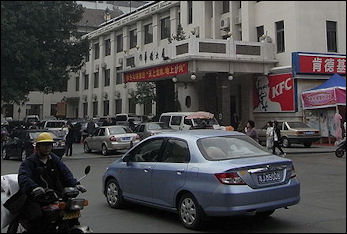TRAFFIC IN CHINA
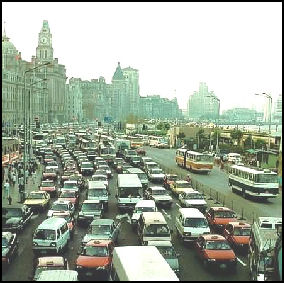
Shanghai traffic Drivers in Beijing complain that rush hour now lasts all day. Even though Beijing has highways with 10 and 12 lanes and six concentric ring roads it can take more than an hour to travel the 6½-kilometer diameter of the city center. To reduce congestion, car access to some streets is restricted, with vehicle only allowed to use these streets on designated days according to the numbers of their license plates, Beijing has not been as aggressive trying to reduce the number of cars as Shanghai and Guangzhou
In 1995, there were 3.5 million bicycles and 350,000 cars in Shanghai. At that time traffic often grinded to a halt with bicycle gridlock when to many bicycles from different directions converged on a single spot. Over the past decade or so bicycles have given way to cars as hard as the Shanghai government has tried to prevent that from taking place.
In the 1980s, planners in charge of overhauling and modernizing Shanghai made a great effort to spare the city traffic jams and pollution by constructed bridges, elevated highways and a new subway system. The government has also tried to keep cars off the road by making it expensive to own a car and difficult to get licence plates and drivers licenses (See Above).
So far the effort has fallen way short of its goals. Shanghai has become choked with cars, fumes, traffic jams and gridlock just like any other city. The planners planned for Shanghai to reach the 2 million vehicle mark in 2020. It reached that figure in 2005 and growth continues at a rate of about 15 percent a year. Another miscalculation has been the subway system. Some lines have fewer than expected riders.
Even if trains are available planners have to overcome an increasingly cavalier American attitude about driving. One Buick owner, who has a new train line extending to his community, told the New York Times, “I’m hoping other people will ride it so that the traffic gets better. I’ll keep driving my car, though. It’s more comfortable because I can listen to music, use the air conditioner, and its not crowded.” He added that fixing Shanghai’s traffic problem was the government’s problem.
To relieve congestion an effort is being made to reserve some roads for cars and others for bicycles. So far the trend favors cars. In 2004, bicycles were banned from all major roads in Shanghai to make more room for cars.
Describing a traffic jam on a relatively lightly-traveled road in Inner Mongolia Peter Hessler wrote in The New Yorker, “It had all started with a few trucks whose fuel lies had frozen. Other motorists began to pass them on the two-lane road, and occasionally they encountered a stubborn oncoming car. Drivers faced off, honking, while the line fo vehicles grew behind them, eventually it became impossible to go in either direction. Some tried to go off road , and the usually made it fifty yards before getting stuck. Men in loafers slipped on the snow, trying to dig out cars with their bare hands, There was no sign of police or traffic control. Meanwhile truckers had crawled beneath their vehicles, where they lit road flares and held them up to their frozen fuel lines.
See Separate Articles: TRANSPORTATION IN CHINA factsanddetails.com ; AUTOMOBILES IN CHINA: GROWTH, POPULAR CARS, NUMBERS factsanddetails.com ; DRIVING IN CHINA: CUSTOMS, TESTS AND BAD HABITS factsanddetails.com ; ROADS IN CHINA factsanddetails.com ; ROAD TRAVEL, TRUCKS AND BUSES IN CHINA factsanddetails.com ; TRAFFIC ACCIDENTS, DRUNK DRIVING AND CAR, BUS AND TRUCK CRASHES IN CHINA factsanddetails.com
RECOMMENDED BOOKS: Country Driving: A Journey Through China from Farm to Factory by Peter Hessler, Peter Berkrot, et al. Amazon.com; Driving toward Modernity: Cars and the Lives of the Middle Class in Contemporary China by Jun Zhang Amazon.com; “English-Chinese and Chinese-English Glossary of Transportation Terms: Highways and Railroads” by Rongfang (Rachel) Liu and Eva Lerner-Lam Amazon.com ; “Decoding China's Car Industry: 40 Years” by Anding Li (2021) Amazon.com; Lonely Planet China" 16 Amazon.com
World's Worst Traffic Jams, in China
China suffered one of the worst traffic on record in October 2015 on the Beijing-Hong Kong-Macau Expressway, one of the nation’s busiest highways, when an ocean of cars spread across 50 lanes was brought to a grinding halt for hours on end as hundreds of millions of people returned home at the end of the Golden Week holiday period that celebrates the founding of the People’s Republic of China. [Source: Jim Gorzelany, Forbes, October 2015]
According to Forbes: While some reports noted foggy weather could have been a factor, a checkpoint officials added along the way reduced the 50-lane expressway to only 20 lanes of traffic. One doesn’t have to be a math whiz to figure that’s a formula for trouble. Traffic was reportedly backed up for hours, though to the credit of the Chinese people, we could find no associated reports of road rage-induced violence among gridlocked motorists. We can only assume whoever was responsible for the artery-clogging checkpoint is now looking for a new job, however.
And this is not even close to being either the world’s worst highway congestion, or the most onerous to occur within China. Back in 2010, a brain numbing 62-mile backup over the Beijing-Tibet expressways lasted for an incredible 12 days and by all accounts earned a place in the traffic jam hall of shame.
Horrendous Traffic Jam in Southern China
Reporting Hetaocun in southern China, Andrew Jacobs wrote in the New York Times, “Compared with some of the more spectacular recent traffic jams in China, among them a 60-mile snarl last summer that paralyzed a major artery outside Beijing for two weeks, the thousands of travelers who spent the night trapped on a snow-coated highway in southwest Guizhou Province on Monday did not even warrant a mention in the local news media. [Source: Andrew Jacobs, New York Times, January 18, 2011]
“The immediate effect of the information vacuum was to suck more unwitting victims — including this reporter — into the morass, which stretched for miles along the four-lane affair linking Guizhou north to Chongqing. Stranded drivers chain-smoked, stomped their feet against the chill and cursed the government for failing to come to their rescue. As the night wore on, fuel lines froze and cellphone batteries died.”
“By noon on Tuesday, more than 12 hours after the blockage began, the frustration and anxiety were mounting. Truckloads of oranges were going bad, and Xi Xinli was nervously eyeing his cargo of 30 hogs, a noisome pile of pink complaining flesh that was bound for the slaughterhouse. “You would be annoyed, too, if you were stuck together like that without food or water,” Mr. Xi said.”
“People were faring no better, especially the busloads of migrant workers who had endured clotted roadways for as long as three days. One especially unlucky bunch left Guangdong Province on Saturday only to find themselves stuck on their bus for eight hours when an earlier bout of freezing rain crippled a portion of southern China. “I’m hungry, but the food they’re selling is too expensive, and I’m tired but too cold to sleep,” said Zhao Ling, 25, a carpenter trying to return home to Chengdu, the provincial capital of Sichuan.”
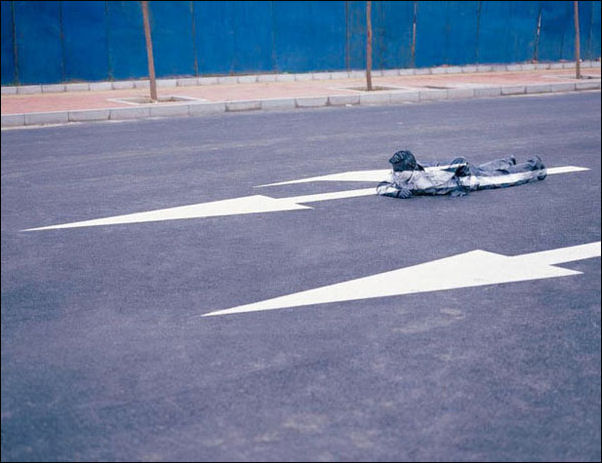
Liu Bolin, China’s Invisible Man artist
“Mr. Zhao and his fellow passengers thought they were smart by traveling before the Chinese New Year’s crush, which starts in earnest next week. In 2008, the last time unusually snowy weather buried China’s southern flank, more than six million people were stranded as they tried to make their way home for the New Year’s holiday. That crisis prompted a national debate about the government’s ability to deal with weather-related calamities and led to a rare, well-publicized apology from Prime Minister Wen Jiabao.”
Much of the region has been battered by unusually cold weather, and earlier this month, a storm shut down most of Guizhou’s highways, including the road to Guangzhou, where thousands were stuck for four days. According to local news reports, the government eventually mobilized with emergency food and water, and gave each trapped passenger 100 renminbi, or about $15. Mr. Zhao and the others would not be so lucky. As the hours passed, he fidgeted in his seat and wondered whether the traffic police would ever show up. “Maybe they all went home early for the holiday,” he said with a smirk.
Benefits of Traffic Jam in Southern China
Andrew Jacobs wrote in the New York Times, “The residents of Hetaocun, however, saw the unmoving necklace of taillights from their mountain village and got entrepreneurial. They roused children from their beds, loaded boxes of instant noodles into baskets and began hawking their staples to a captive clientele. The 500 percent markup did not appear to dent sales. “It rarely snows here, so this is a good thing,” said Yi Zhonggui, 42, as he wove past stalled vehicles with his wife and 4-year-old daughter lugging thermoses of hot water.” [Source: Andrew Jacobs, New York Times, January 18, 2011]
“As the supply of noodles ran low, residents began gathering up the walnuts that give the village its name. In between cries of “walnuts, walnuts,” salesmen like Chen Xianneng obliged the desperate with snippets of news from the front, even if the information was based on hearsay. “The roadway is frozen, and the trucks can’t get down the hill,” he would say, cracking shells open with his bare hands as a sort of sales pitch.” (Later, it became apparent that an overturned truck carrying toilets was largely responsible for the mess.)”
“Moments later came a cascade of shouts, followed by the honking of horns and then the coughing of starting engines that became contagious. As people scurried back into their vehicles, the bedraggled, frozen column began to creep forward, slowly at first, but then with more resolve.”
“The hawkers from Hetaocun stepped back onto the highway shoulder, their expressions forlorn. But then the snow began to fall again and Mr. Yi, the farmer-turned-noodle vendor, began to smile. He repeated the weather forecast he had heard that morning — several more days of freezing precipitation — and told his wife to stay put. “Don’t worry,” he said. “They’ll get stuck again.”
Beijing Traffic
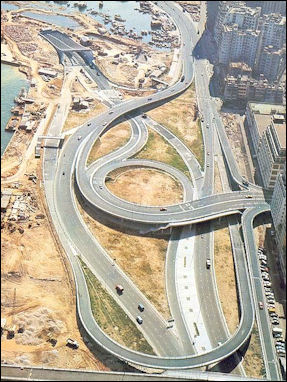
As of December, Beijing counted 4. 7million registered vehicles, with 2,000 new ones joining the clog each day. That is more than 700,000 new vehicles this year, which was up from 550,000 new vehicles last year, 376,000 in the preceding year and 252,000 the year before that. When the number reaches 6.5 million, traffic researchers calculate, the Beijing streets will be fully saturated. Some would say they already are: in June, a survey by I.B.M. of 20 global metropolises rated Beijing traffic as tied for the world’s worst, along with Mexico City.[Source: Michael Wines, New York Times, December 22, 2010]
Barbara Demick wrote in the Los Angeles Times, “Besides the increased traffic in Beijing, the run on car sales has resulted in such practical problems as where to park the vehicles. Wu Caibao, a university administrator who bought a red Chevy in April, said the problem just keeps intensifying. "So many of my neighbors have bought cars recently that I have to come home early from work just to find a place to park." Chinese economic policies are designed to nurture domestic automakers and make car ownership accessible to people who half a generation ago thought themselves lucky to afford a bicycle. The Chery QQ, for example, sells for about $4,500. [Source: Barbara Demick, Los Angeles Times, January 28, 2011]
Beijing Traffic Reaches Alarming Levels in 2010
Barbara Demick wrote in the Los Angeles Times, “Beijing is girded by concentric ring roads that feel like nooses strangling the city during peak traffic hours. It is not uncommon for trucks headed into the city to be backed up for days. One epic jam in August 2010 lasted nine days, and during a rainy Friday in September, the capital almost came to a standstill, prompting concerns from the Politburo about how the government of the world's most populous country could function if nobody could move.” [Source: Barbara Demick, Los Angeles Times, January 28, 2011]
In July 2010 Beijing city officials noted that rush-hour traffic speed had dropped nearly 4 percent in one year, to an average of 15 miles per hour, and was headed for 9 miles an hour by 2015. That is, roughly, bicycle speed. One the taxi driver told the New York Times that he recalled a jam in February 2010 that left him and his passengers stalled for nearly three hours. “It was a combination of rain and everyone going on vacation before Spring Festival,” he said. [Source: Michael Wines, New York Times, December 22, 2010]
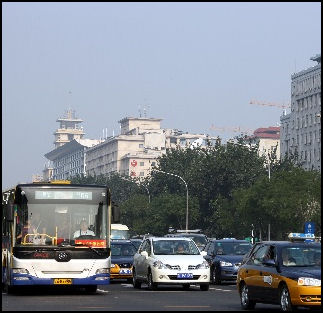
Beijing traffic “In September, another vacation exodus — this time for Autumn Festival — gridlocked the entire city, leading to 140 traffic backups in the evening rush hour,” Michael Wines wrote in the New York Times. “According to a senior journalist at one official media outlet, that episode prompted President Hu Jintao and Prime Minister Wen Jiabao to weigh in, asking Beijing city and Communist Party leaders what was to be done. The journalist, who asked not to be named for fear of repercussions, said Beijing leaders had suggested ways to halt population growth in Beijing and cap the number of new automobiles. Mr. Hu was said to have rejected some of the more restrictive proposals as too draconian for a progressive national capital. The city opted instead to throw more traffic officers onto the streets.
In September 2010 Evan Osnos wrote in the The New Yorker website: “Something strange is happening in Beijing: The city is freezing up. The Chinese capital has always functioned in a register of productive and tolerable clamor: busy, frenetic, and congested, yes, but manageable and irresistibly interesting. Cabbing across town at rush hour usually required reading material heftier than a periodical but lighter than Proust. [Source: Evan Osnos, The New Yorker website, September 21, 2010]
But over the summer and into the fall, something deep in the municipal DNA has gone berserk and is replicating fast enough to turn the city into “a giant, nightmarish, gridlocked parking lot,” as The Wall Street Journal’s Shai Oster put it last month. First, there was the bizarre, metaphor-friendly ten-day traffic jam on a sixty mile stretch of highway outside of the city’sparked, it seemed, by a flurry of coal deliveries to factories — but now we are looking at something less like a freak event and more like a devolution of the species. As Oster points out this week, the congestion seems to have passed some imperceptible Rubicon and become, more or less, unworkable. These photos, circulating around the Chinese Web, show people walking beside their cars. It doesn’t have quite the drama of the usual abandoned-cars-with-doors-open sci-fi set piece, but it’s getting there.
Part of the problem is that the city’s usual car-use restrictions are being lifted over the Mid-Autumn and National Day holidays. But, far more relevant, is the fact that the population has hit nearly twenty million — a decade ahead of projections — fueled by a constant influx of migrants in search of opportunity. And who could blame them? But with Beijingers driving off the lots with new cars nearly two thousand times a day — and coming to a halt a few feet away, one assumes — this is the right moment to point out that electric bikes just might be one signpost to salvation. I’ve been riding the Turtle King more than ever this fall and have come to see Beijing as two cities in one: a paralyzed, Hobbesian mess in the center of the road, and a fleet, functioning, open-air society on the edges. Take your pick.
Reasons for Awful Beijing Traffic

Train and traffic going to the Great Wall Michael Wines wrote in the New York Times: “Part of the problem is poor planning. Curiously, a city of more than six million drivers has virtually no stop signs, turning intersections into playing fields for games of vehicular chicken. Freeway entrance ramps appear just before exit ramps, guaranteeing multilane disarray as cars seeking to get off try to punch through lines of cars seeking to get on. Beijing drivers do not help. The city’s driving style is best likened to a post-holiday sale in which dozens of shoppers mill about a single bin, elbowing for advantage — in this case, entry to a single lane of traffic that is probably blocked by a taxi anyway.” [Source: Michael Wines, New York Times, December 22, 2010]
“We have built many flyovers and expressways,” Zhao Jie, a transportation expert at the China Academy of Urban Planning and Design, told the New York Times. “We have spent quite a lot of money on subways and bus lines, and Beijing probably has the lowest bus fares in the world. But the stimuli to car ownership are even more powerful.” Duan Haizhu, a 26-year-old taxi driver, put it more elegantly during a recent crosstown crawl in his orange-and-brown Hyundai. “The speed of building roads is nowhere near the speed of people buying cars,” he said. “And people won’t stop buying cars.”
Week-Long Traffic Jam Outside Beijing
In 2010, Beijing and Mexico City were named as having the world’s worst traffic jams. In August 2010, a huge traffic jam — up to 60 miles long, on a freeway linking Beijing and Inner Mongolia’s capital, Hohhot — trapped drivers for days and provided money-making opportunities for locals selling cup of noodles to stranded drivers for outrageous prices. “I spent five days and five nights last week without moving,” he told the New York Times. “part from sleeping, you just eat. And you can only eatthe instant noodles. These cost about 45 cents, from a roadside hawker, plus $1.20, for the water needed to soften them.”[Source: Michael Wines, New York Times, August 27, 2010]
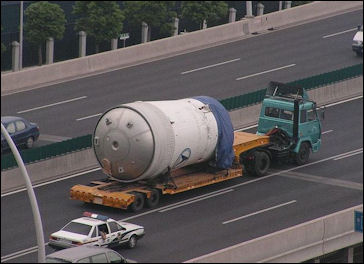
Carrying a rocket part
on the highway Michael Wines wrote in the New York Times, “The gridlock has been building for up to a year, the inevitable result of the difficulty of China’s construction crews in keeping up with China’s breakneck growth.In this case, a government decision to satisfy surging demand for electric power by tapping Inner Mongolia’s coalfields has flooded local highways with thousands of coal trucks, overwhelming police officers’ best efforts to herd them.
“The government is building two new rail lines on the trucks’ route, one for coal and the other for freight, as well as a second passenger-only line to relieve congestion. But those railroads will not open until at least 2012, and perhaps later...And so huge traffic jams... are all but guaranteed to continue. Indeed, logistics experts here say the miracle is that more such bottlenecks do not occur.”
The Beijing-Hohhot highway problem has been blamed on government construction not being able to keep up its ambitious energy plans. “Mongolian coal production has exploded — up 37 percent to 637 million tons last year alone, with an additional 15 percent increase expected this year. Much of the coal is supposed to move to seaports on China’s east coast, to be shipped to big cities in the south. But pig-in-python style, even China’s brand-new freeway system cannot handle the volume.”
“On an ordinary freeway, the 300-mile drive from Hohhot to Beijing would consume several hours. Here, China’s coal haulers say, the same trip generally requires up to three days’ travel, including weight checks and unloading coal. Recent traffic jams have pushed travel time to a week or more.”
“But even moving west to Beijing — a six-lane stretch that winds past popular Great Wall tourist sites — traffic jams can stall drivers for hours. On a recent evening, a passenger whiled away two hours on a deadened stretch 60 miles from Beijing, as thousands of coal trucks idled and vendors darted among the vehicles, selling apples and other treats....The more roads they build, the more congested it gets, one trucker said...And then they build some more roads.”
Beijing Keeps Car Restrictions

road work at a tunnel In April 2009, the car restrictions put in place for the Beijing Olympics were extended an additional 12 months. A fifth of the city's private vehicles and a third of official cars will continue to be barred from the roads every weekday, the Beijing Traffic Management Bureau has said. [Source: Jonathan Watts, The Guardian, April 6, 2009]
By keeping these vehicles off the road, the city's environmental protection bureau estimates that emissions have been kept down by 375 tons daily or 10 percent. A further measure to extend a ban on high-polluting cars and trucks from the center to cover the whole city will save a similar amount, it estimated.
Opinion was mixed about the desirability of the extension. “I feel these controls are a violation of people's rights. The government hasn't looked after the interests of car owners,” a new driver told The Guardian. “If they want to reduce traffic they should use economic measures, such as higher petrol taxes, rather than directly ordering people off the road.” To get around the license plate system some people have bought beat up old cars to drive on the day they were not allowed to drive on.
Beijing Traffic Plan
Parking on the sidewalk Describing the main components of a new a traffic plan for Beijing introduced in December 2010, Michael Wines wrote in the New York Times: “280,000 new parking spaces; 1,000 share-a-bike stations; 348 miles of new subway track; 125 miles of new downtown streets; 23 miles of tunnels; 9 new transportation hubs; 3 congestion zones; and 1 cure-all, “the use of modern technology.” But even all that has been largely dismissed as not enough. [Source: Michael Wines, New York Times, December 22, 2010]
Michael Wines wrote in the New York Times, “To be fair, perhaps few cities could have handled Beijing’s driver-population explosion better. Twenty years ago, Beijing was a city of bicycles and shabby, charming alleys, a single limited-access highway tracing a lazy rectangle around the Forbidden City and Tiananmen Square. Today, five freeways girdle the city, eight more spoke from the suburbs to downtown, and the subway soon will stretch to 10 times its 1990 length.”
New public transit initiatives are also underway. In late December, for example, Beijing opened five new subway and rail lines. But Beijing's transit system is not nearly as well-designed as the one in Shanghai, which has a larger population but just one-third of the number of cars. (Shanghai has imposed limits since the 1980s on the number of autos that can be registered in the city and sells license plates through an auction system.)
The December 2010 proposal, Wines wrote, was “a clear compromise of better public transportation — longer subways and bike racks — and the parking lots, tunnels and surface roads that Beijing’s auto-centric society craves. And it hints at more restrictive measures, including limiting new car purchases to buyers who can prove Beijing residence, or even capping the number of cars that can be registered here annually.”
Image Sources: 1) University of Washington; 2, 9, 10) Beifan.com 3, 5 ) Nolls China website ; 4) Mongabey ; 6) CIA; 7) Gary Braasch; 8) Julie Chao; Wiki Commons; Liu Bolin, China’s Invisible Man artist, Global Times Chinese: photo.huanqiu.com Text Sources: New York Times, Washington Post, Los Angeles Times, Times of London, National Geographic, The New Yorker, Time, Newsweek, Reuters, AP, Lonely Planet Guides, Compton’s Encyclopedia and various books and other publications.
Last updated July 2022


